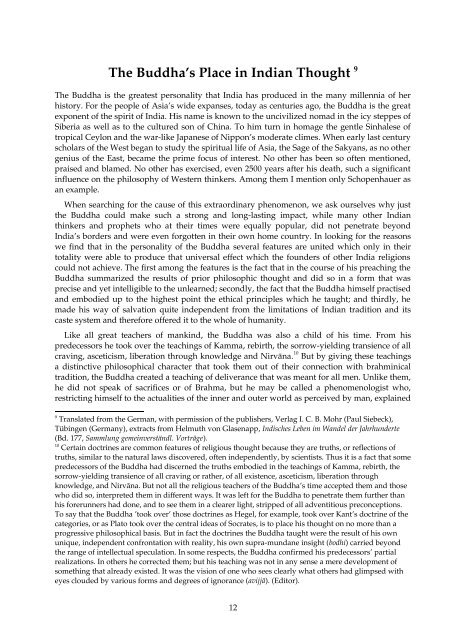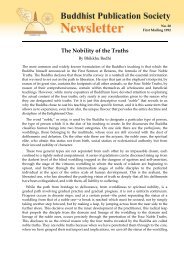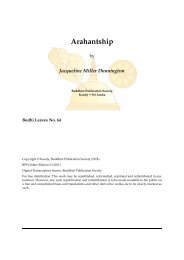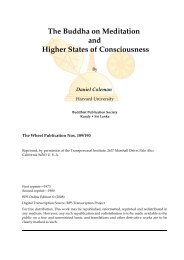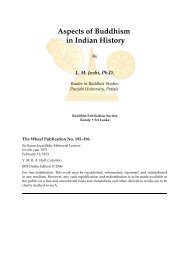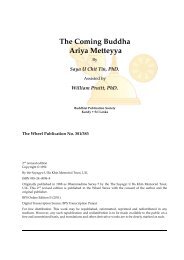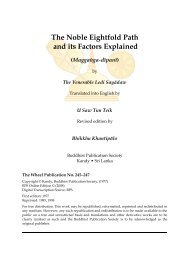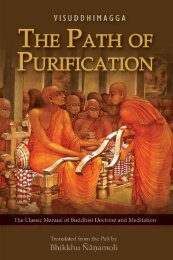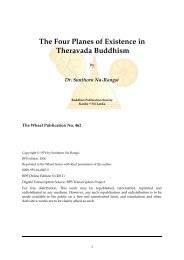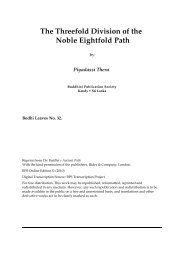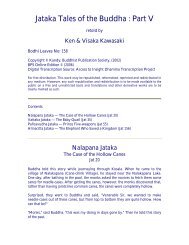Buddhism and Comparative Religion and Other Essays - Buddhist ...
Buddhism and Comparative Religion and Other Essays - Buddhist ...
Buddhism and Comparative Religion and Other Essays - Buddhist ...
Create successful ePaper yourself
Turn your PDF publications into a flip-book with our unique Google optimized e-Paper software.
The Buddha’s Place in Indian Thought 9The Buddha is the greatest personality that India has produced in the many millennia of herhistory. For the people of Asia’s wide expanses, today as centuries ago, the Buddha is the greatexponent of the spirit of India. His name is known to the uncivilized nomad in the icy steppes ofSiberia as well as to the cultured son of China. To him turn in homage the gentle Sinhalese oftropical Ceylon <strong>and</strong> the war-like Japanese of Nippon’s moderate climes. When early last centuryscholars of the West began to study the spiritual life of Asia, the Sage of the Sakyans, as no othergenius of the East, became the prime focus of interest. No other has been so often mentioned,praised <strong>and</strong> blamed. No other has exercised, even 2500 years after his death, such a significantinfluence on the philosophy of Western thinkers. Among them I mention only Schopenhauer asan example.When searching for the cause of this extraordinary phenomenon, we ask ourselves why justthe Buddha could make such a strong <strong>and</strong> long-lasting impact, while many other Indianthinkers <strong>and</strong> prophets who at their times were equally popular, did not penetrate beyondIndia’s borders <strong>and</strong> were even forgotten in their own home country. In looking for the reasonswe find that in the personality of the Buddha several features are united which only in theirtotality were able to produce that universal effect which the founders of other India religionscould not achieve. The first among the features is the fact that in the course of his preaching theBuddha summarized the results of prior philosophic thought <strong>and</strong> did so in a form that wasprecise <strong>and</strong> yet intelligible to the unlearned; secondly, the fact that the Buddha himself practised<strong>and</strong> embodied up to the highest point the ethical principles which he taught; <strong>and</strong> thirdly, hemade his way of salvation quite independent from the limitations of Indian tradition <strong>and</strong> itscaste system <strong>and</strong> therefore offered it to the whole of humanity.Like all great teachers of mankind, the Buddha was also a child of his time. From hispredecessors he took over the teachings of Kamma, rebirth, the sorrow-yielding transience of allcraving, asceticism, liberation through knowledge <strong>and</strong> Nirvāna. 10 But by giving these teachingsa distinctive philosophical character that took them out of their connection with brahminicaltradition, the Buddha created a teaching of deliverance that was meant for all men. Unlike them,he did not speak of sacrifices or of Brahma, but he may be called a phenomenologist who,restricting himself to the actualities of the inner <strong>and</strong> outer world as perceived by man, explained9Translated from the German, with permission of the publishers, Verlag I. C. B. Mohr (Paul Siebeck),Tübingen (Germany), extracts from Helmuth von Glasenapp, Indisches Leben im W<strong>and</strong>el der Jahrhunderte(Bd. 177, Sammlung gemeinverständl. Vorträge).10Certain doctrines are common features of religious thought because they are truths, or reflections oftruths, similar to the natural laws discovered, often independently, by scientists. Thus it is a fact that somepredecessors of the Buddha had discerned the truths embodied in the teachings of Kamma, rebirth, thesorrow-yielding transience of all craving or rather, of all existence, asceticism, liberation throughknowledge, <strong>and</strong> Nirvāna. But not all the religious teachers of the Buddha’s time accepted them <strong>and</strong> thosewho did so, interpreted them in different ways. It was left for the Buddha to penetrate them further thanhis forerunners had done, <strong>and</strong> to see them in a clearer light, stripped of all adventitious preconceptions.To say that the Buddha ’took over’ those doctrines as Hegel, for example, took over Kant’s doctrine of thecategories, or as Plato took over the central ideas of Socrates, is to place his thought on no more than aprogressive philosophical basis. But in fact the doctrines the Buddha taught were the result of his ownunique, independent confrontation with reality, his own supra-mundane insight (bodhi) carried beyondthe range of intellectual speculation. In some respects, the Buddha confirmed his predecessors’ partialrealizations. In others he corrected them; but his teaching was not in any sense a mere development ofsomething that already existed. It was the vision of one who sees clearly what others had glimpsed witheyes clouded by various forms <strong>and</strong> degrees of ignorance (avijjā). (Editor).12


